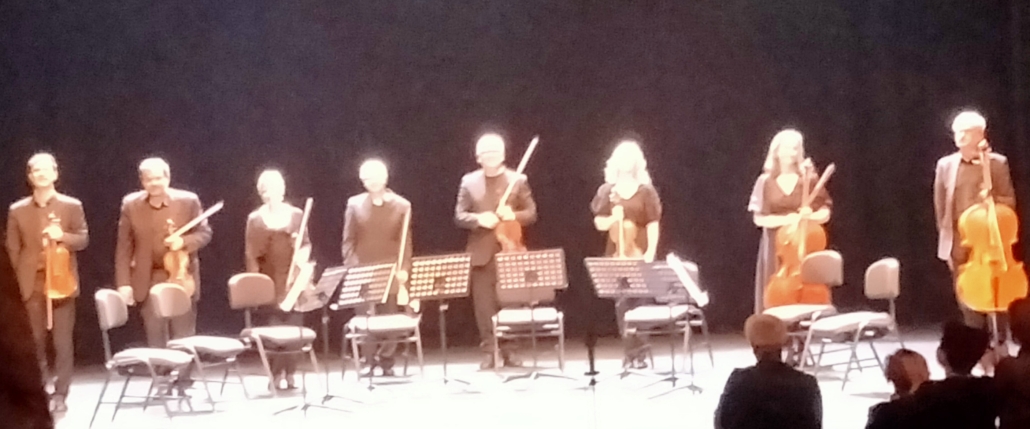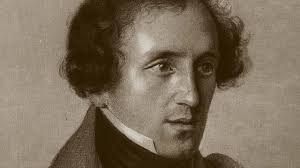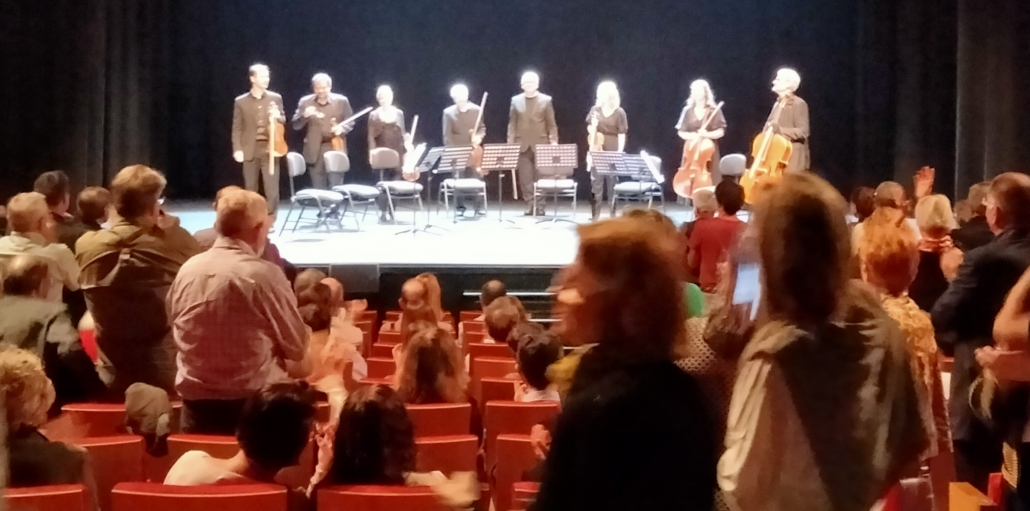PLAYERS PICK THREE COMPOSERS
PLAYERS PICK THREE COMPOSERS
Academy Of St Martin In The Fields
40 FIMC
El Salinero Theatre, Arrecife, Lanzarote, 1st Feb
review by Norman Warwick
It felt strange to be sitting in a Lanzarote theatre waiting to welcome Britsh musicians to the stage. This was not a full size St. Martin In The Fields, but was eight representatives who played beautifully.

The Canary Islands Music Festival, in its En Paralelo section, presented this exquisite chamber program by the Academy of St Martin in the Fields (shown left and right). Prior to the concert we heard tonight the eight-strong ensemble had played in the capital’s auditoriums, and this octet from the British group had toured several Canary Islands with a baroque-romantic repertoire.

Although I had lived in the UK for sixty five years, I had never seen any live performances by St Martin In The Fields musicians, although we had seen them on tv many times. This was a luxury opportunity to enjoy the good work of this London orchestra, considered to be one of the best chamber ensembles in the world, thanks to its brilliant performances. They joined the celebration of the 40th FIMC, which began with a select repertoire that included the Ricercare a 6 of Bach’s famous Musical Offering, one of the masterpieces of the Baroque.
Tonight they continued with Brahms’ Sextet No. 1, a work for strings that reflects, in a balanced and simultaneous way, Brahms’ fascination with the violin and his delight in the expressive power of the accompanying instruments. A few years before this work, a romantic chamber music reference, at the dawn of musical romanticism, Mendelssohn composed his Octet for Strings, a piece that completes this program. A score completed when the German musician was 16 years old, being one of his best early works.

The opening piece, JS Bach: Musical offering, BWV 1079: Ricercare at 6 was played by a small number of musician from the full ensemble of St Martin In The Fields. Six of these eight touring musicians represented their larger ensemble and their country wonderfully well.
The six players who were on stage for the Bach offering played beautifully but, I think through no fault of their own, Bach sounded, as I usually find when listening to Bach´s work just a little too busy, distracting from the beauty of his main melodic lines.
However the second and third pieces offered to us tonight were absolutely first class.
Reading a piece by Orrin Howard, who served the Los Angeles Philharmonic as Director of Publications and Archives for more than 20 years has written well on this particular piece, at The Hollywood Bowl Concert Hall online site.

Strange as it may seem to those of us who merely listen in to beautiful classical music but are not qualified to consider it objectively, it seems Johannes Brahms (right) clearly had a hang up when it came to writing for strings. He certainly did very well by the violin and cello in the B-major Piano Trio when he was barely 20, in 1853, but he found it easier to combine six strings, which he did in two sextets just a few years later, than he did in the Haydn-Mozart-Beethoven-proven string quartet, which he didn’t venture until about 1865, well after the sextets. And he composed his only violin concerto a year before turning out a sonata for violin and piano. Don’t look for a logical explanation; the ways of this ever-cautious creative genius are wonderfully mysterious.
The most accessible of the strings, the violin, was not Brahms’ personal instrument, but he came to understand it in a very personal way, in an almost hands-on way. When he was only 17 he went on the road as accompanist to the Hungarian violinist Eduard Reményi. At the elbow of this brilliant player, young Johannes learned much about the instrument’s technique and capabilities and, as a bonus, came to know and love the Hungarian music Reményi always included on his programs. But his debt to Reményi didn’t stop there, for it was he who introduced the young composer to Joseph Joachim who, although only two years older than Brahms, was at age 21 already a famous artist, known from the time he was 13 when he played the Beethoven Violin Concerto under Mendelssohn’s baton. It was Joachim who made possible Brahms’ introduction to the Schumanns – Robert and his pianist wife Clara – a relationship that was crucial to his career and his life. As was his life-long friendship with Joachim.
The appeal to Brahms of a string sextet was based, one supposes, on the possibilities presented by the deep sonority of its two cellos and two violas playing off the soprano brilliance of two violins. As we know from his orchestral music, Brahms reveled in the gutsy strength and soulful expressiveness of the lower instruments. So it’s no surprise that his first sextet begins with a cello singing tenderly the main theme. (A quick word about the rhythm here: the time signature says three beats to a measure, but this main theme falls precisely in four beats. In the 19th century, composers rarely if ever used different time signatures in the same piece, but Brahms was a rhythmic rascal and his cross rhythms are legion, which is one reason Schoenberg admired him so much.)
The movement is rich in themes, one of the most memorable being the extension to the main theme, in triplets, a rhythmic unit to which Brahms was especially partial. Everywhere in this movement, and indeed in the entire sextet, Brahms’ exceptional ability to unify his material through thematic transformation, and by using melodic kernels as comfortingly recognizable signposts along the way, brings wonderful cohesion to the music. It’s easy to point out many distinctive passages, but to mention just one: where an extension of the triplet theme is in the violins, with violas and cellos playing opposing-valued notes, creating extreme agitation as a prelude to the simple, lyrical subordinate theme in the violins, now in minor.
When it comes to the composition of this piece, the asforementioned Orrin Howard wrote that
Recounting the splendours of the first movement could go on and on and would include the masterful unfolding of the development section, but the remainder of the sextet has its own distinctions. The second movement is a theme and six variations – a minor-key theme presented by a viola – and in the classical variation form Brahms is second to none, before or after him. The third movement is a scherzo with more than a little rustic flavour, and the concluding rondo has more than a little Schubert in it, particularly in the spring-like main theme sung gracefully by a cello. Notwithstanding the Schubert resemblance, the remainder of the movement is pure Brahms, with all the compositional invention and sonorous splendors that bespeaks.
I can only add to that observation by saying that the Academy of St Martin In The Fields delivered the Sect in B with more than a touch of flair, and it all skipped along very merrily.
While the genre of the string quartet – consisting of two violins, one viola and one cello – developed slowly over the second half of the eighteenth century, it had, by the turn of the nineteenth century, achieved such a wide popularity as to be regarded as the vehicle par excellence of both chamber music and “modern” music of the era. The string quartet’s repertoire was then still rather limited, however, despite the contributions of dozens of composers to satisfy audiences’ demands for works in this new medium. The unusual (for the time) instrumentation of Mendelssohn’s Octet (1825), scored for four violins, two violas and two cellos – in essence, a double string quartet – is therefore as unexpected as it is brilliantly innovative.
While it has been assumed that the Octet‘s novel instrumentation may have been inspired by a nearly contemporary work, the Double Quartet in D minor, op. 65 (1823) by German composer Louis Spohr (1784-1859), which uses the same combination of strings as in Mendelssohn’s Octet, Spohr’s approach to scoring his work is more “antiphonal” in conception: that is, the two relatively independent quartets play off each other, and at other times in unison, as a single instrumental group. Spohr himself compared his own Double Quartet to “two choirs,” and also remarked that Mendelssohn’s approach to scoring the Octet was a more “collaborative” effort for all eight instruments used in the work.

Unlike Spohr’s work, Mendelssohn (left) explores the full range of expressive and textural resources available to this particular combination of instruments, a perspective that is larger in scope – more “symphonic” in conception – than that usually encountered for the smaller scale of chamber music. More closely aligned with the expressive style of emerging musical Romanticism than with the established Classicism of the Berlin Singakademie and to the teachings of his musical mentor, Carl Friedrich Zelter, the sixteen-year old Mendelssohn’s creative voice had attained a level of maturity and invention that exceeded that of any prodigy before him, including Mozart.
The most astonishing fact about the composition of the Octet is not that it was written by someone of such a young age, but that such a personal and mature musical language is so evident throughout the work – no small achievement for a composer of any age. While the work’s light, vivacious mood and the organic development of its musical content would seem to indicate that the work was composed in a spontaneous burst of creativity, we do know that the work underwent significant changes before, and even after, its initial publication in 1832, involving painstaking work on the composer’s part. It is therefore quite amazing that the work appears to have lost none of its vigor in the process. (This process of revising his works became a lifelong obsession for Mendelssohn, much to the frustration of his publishers!)
Mendelssohn began the composition of the Octet, the first indisputable masterpiece of his artistic maturity, in the autumn of 1825. The work was completed on October 15, 1825, two days before the composer presented the autograph score as a birthday present to his violin teacher, Eduard Rietz. Rietz returned his student’s compliment by copying out instrumental parts by hand which were used in the work’s first performance. From contemporary accounts of those in attendance at that performance, the Octet apparently delighted and amazed its audience, a reaction that this work has been evoking ever since.
As mentioned above, Mendelssohn’s personal aesthetic conformed ideally to the musical tastes of the era, which were moving from a “Classical” style (that of Mozart, Haydn, etc.) to a more “Romantic” one (espoused by Beethoven, and later by Brahms, Mahler, etc.). The composer did, however, introduce a particular element into the musical language of his time, the evocation of an enchanted, ethereal world of fairies and other benevolent spirits, the inspiration for which likely derived from his reading of the works of William Shakespeare, as well as of German poet and dramatist Johann Wolfgang von Goethe (1749-1832), with whom Mendelssohn was personally acquainted. A verse from the first part of Goethe’s lyric poem Faust (1775-1808), in fact, is alleged to have inspired the Scherzo movement from the Octet:
Wisps of cloud and mist
Are lit from above
Breeze in the foliage and wind in the reeds
And all is scattered.
The composer’s sister Fanny wrote that Mendelssohn once revealed his vision of the Scherzo movement to her: that “the whole piece is to be played staccato and pianissimo… the trills passing away with the quickness of lightning… one feels so near to the world of spirits, carried away in the air, half inclined to snatch up a broomstick and follow the aerial procession… and at the end, …all has vanished.” The mood of the Scherzo movement from the Octet, to which Mendelssohn himself attached special importance (he even arranged the movement for full orchestra in about 1829), was recreated the following year in his Midsummer Night’s Dream overture, based on Shakespeare’s play of the same name, and depicting the fleeting twilit moments when the world of humans meets that of the spirits.
The holograph manuscript score of the Octet is undoubtedly the most significant treasure within the Library of Congress’s holdings of material related to Mendelssohn. Previously owned by the music publishing firm Musikbibliothek Peters (to which its original owner, Rietz, entrusted it), it was only upon its purchase by the Library in 1951, with funds generously provided by philanthropist Gertrude Clarke Whittall, that the score was first made accessible for public examination. The manuscript, representing Mendelssohn’s initial concept of the work, contains a number of significant markings and musical content that were subsequently excised from the work’s first publication in 1848. Considering the composer’s convention of revising his works at least once, if not multiple times, and his tendency to destroy early drafts or versions of them, the original manuscript of the Octet presents the researcher with a unique insight into the creative process of the young genius. Particularly noteworthy are the manuscript’s front flyleaf, which bears Rietz’s signature, and the score’s first page, on the upper right corner of which, in Mendelssohn’s hand, are the letters “L. e. g. G.” – an abbreviation of the German Lass es geling, Gott (“Let it succeed, God!”).
Before his premature death at age thirty-eight, Felix Mendelssohn was to compose five symphonies, numerous other orchestral, stage and chamber works, and literally hundreds of vocal works ranging from solo song to large scale choral works (such as the popular oratorio Elijah of 1836, based on the Biblical account of the prophet’s life). The Octet, however, holds a unique place among Mendelssohn’s works as one of the first major successes for its composer. From the almost minimalist unison textures of the work’s Scherzo, to the eight-part fugato of its Finale, Mendelssohn created a masterwork which German composer and violinist Louis Spohr praised as “quite another kind of art.”

The performance of this piece by the octet from the Academy of St Martin In The Fields (right) was quite wonderful. Every instrument fully contributed to the overall sound as the melody line that flew freely around the auditorium. There is something in Mendelssohn´s music that stays with a listener even after a first hearing…. to put in terms of popular music it passes the Old Grey Whistle Test in the sense that you are not only humming it as you leave the theatre but also the next morning as you drive to work, or down to the beach !
Mendelssohn´s music was what I chose for my soundtrack to my Just Poets website which ran throughout the nineteen nineties. It was a gorgeous background whenever I was working on the site, (every morning from 6 to 10 pm) and made every mis-spelled word, every computer with an ideas of its own moment, was typed out such mellifluous music that not even the gone-cold cup of tea, phone calls and e mail pings could dampen the great to be alive feeling Mendelssohn delivered.
Unusually there were no hard copy programmes available on the night at El Salinero Theatre, and we had to photograph a sign with the QRL instead. This might have been because the programme, which is produced for each touring artist involved in the annual tour-de-force that is the Festival of International Classical Music of The Canary Island had been devoured by fans at the several other concerts the ensemble had already played on the tour of the eight islands
.Nevertheless, The front of house staff at El Salinero were their usual, helpful, courteous and smiley selves. The parking around the theatre hasn´t become any easier over the years. When every youth on the island has turned up to throw hoops or fulfil a regime of press ups and star squats, or play indoor five a side football traffic slows and spaces on the UD Lanzarote car park disappear very quickly.
So it is well worth leaving home early, because these concerts are not to be missed.




Leave a Reply
Want to join the discussion?Feel free to contribute!